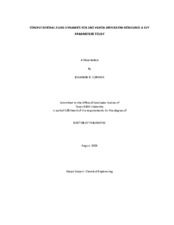| dc.description.abstract | The increased demand for liquefied natural gas (LNG) has led to the construction of several new
LNG terminals in the United States (US) and around the world. To ensure the safety of the
public, consequence modeling is used to estimate the exclusion distances. The purpose of
having these exclusion distances is to protect the public from being reached by flammable
vapors during a release. For LNG industry, the exclusion zones are determined by the half
lower flammability limits (half LFL, 2.5% V/V). Since LNG vapors are heavier‐than‐air when
released into atmosphere, it goes through stages, negative, neutral and positive buoyant effect.
In this process, it may reach the half LFL.
The primary objective of this dissertation is to advance the status of LNG vapor dispersion
modeling, especially for complex scenarios (i.e. including obstacle effects). The most used
software, box models, cannot assess these complex scenarios. Box models simulate the vapor
in a free‐obstacle environment. Due to the advancement in computing, this conservative
approach has become questionable. New codes as computational fluid dynamics (CFD) have
been proven viable and more efficient than box models. The use of such advance tool in
consequence modeling requires the refinement of some of the parameters. In these
dissertation, these parameters were identified and refine through a series of field tests at the
Brayton Firefighter Training Field (BFTF) as part of the Texas A&M University System (TAMUS).
A total of five tests contributed to this dissertation, which three of them were designed and
executed by the LNG team of the Mary Kay O'Connor Process Safety Center (MKOPSC) and the
financial support from BP Global SPU Gas (BP). The data collected were used as calibration for
a commercial CFD code called CFX from ANSYS. Once the CFD code was tuned, it was used in a sensitivity analysis to assess the effects of parameters in the LFL distance and the concentration
levels. The dissertation discusses also the validity range for the key parameters. | en |


